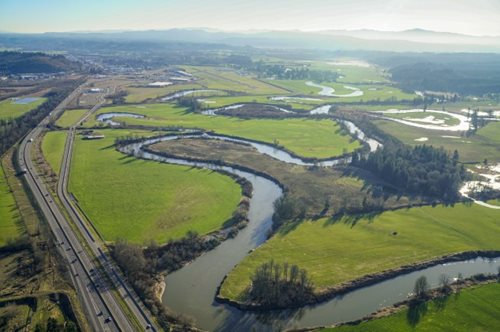The Washington Legislature has approved $60 million in state and federal funding to continue implementing projects to reduce damage from catastrophic floods and restore critical aquatic habitat in the Chehalis River basin.
The Chehalis Basin Strategy is an integrated approach for reducing flood damage and restoring aquatic habitat in Washington’s second-largest river basin, where salmon runs are in decline and major floods are getting larger and more frequent. The Legislature created the Office of Chehalis Basin within the Washington Department of Ecology to aggressively pursue solutions to these challenges.
Chrissy Bailey, senior project manager for the Office of the Chehalis Basin, has been working with the community, the Chehalis and Quinault tribes, and local Chehalis basin planning authorities since 2015. Working in partnership, the community, the two tribal governments and Gov. Jay Inslee requested $60 million to continue developing the strategy through 2019.
“The timing for the legislative funding could not be better,” Bailey said. “Last year, we completed an environmental assessment evaluating potential combinations of actions to reduce flood damage and restore aquatic habitat in the basin. This additional funding will ensure we can get to work and continue making progress.”
The new funding will be used for planning and projects across the Chehalis basin:
- About $30.4 million will be used to advance the long term strategy, including environmental reviews for different flood-damage reduction and habitat restoration projects, collecting data, evaluating the engineering design and feasibility of potential future construction projects, and engaging tribal governments, state agencies and other parties.
- The other $29.6 million will be spent on the design and construction of priority flood protection (pdf) and habitat restoration projects, including $2.5 million to construct a project in the city of Centralia designed to restore natural landforms and recreate stream channels for fish habitat in China Creek while slowing down and storing more stormwater runoff when stream flows are high.
“The people of the Chehalis River basin need this critical state investment to continue. They also need to know how this funding will be put toward the highest, best possible uses,” said Vickie Raines, a Grays Harbor County commissioner and chair of the Chehalis Basin Board that oversees the strategy. “We need to keep working together to find solutions that protect our communities and our environment. The two issues go hand in hand.”
During the two-year 2015-17 state budget cycle, the Legislature made a $50 million investment in the strategy contributing to the early flood-warning systems throughout the Chehalis River basin and bringing together local and tribal governments, state and federal agencies, conservation districts and nonprofit organizations to restore 33 wetlands and connect or remove more than 27 fish barriers opening up 135 miles of basin stream habitat. Those groups have also completed 19 local flood damage-reduction projects while other studies and projects are underway.


